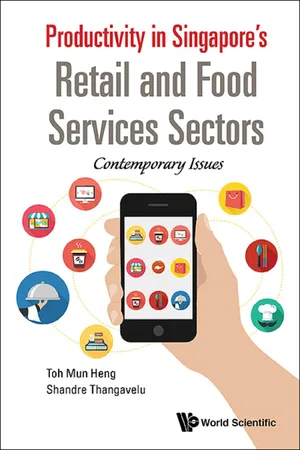
Productivity in Singapore's Retail and Food Services Sectors
Contemporary Issues
- 268 pages
- English
- ePUB (mobile friendly)
- Available on iOS & Android
Productivity in Singapore's Retail and Food Services Sectors
Contemporary Issues
About This Book
-->
The Retail and Food Services sectors play an important role in Singapore. They add to the vibrancy of the economy and contribute to the social well-being of Singaporeans. At the same time, they are often highlighted and scrutinised for their low productivity performance and high reliance on manpower. There is to date a lack of local literature that addresses the issues faced by the two sectors at the enterprise and worker levels.
This timely book includes major topics in services productivity in the Singapore context, with emphasis on Retail and Food Services. Topics covered include the key productivity levers of the services sectors: holistic productivity measurement framework, effective entrepreneurship, manpower management, promotion by social media, marketing, costing process and accounting sophistication. These areas are explored through literature reviews and in-depth interviews with companies and consumers. The chapters also include recommendations for policy makers and industry stakeholders. Written in a simple and accessible manner, this book will serve as an insightful guide to researchers, policy-makers, industry practitioners and enterprises and those who are keen to learn from the Singapore experience.
--> Contents:
- Introduction
- Analysis of Singapore's Productivity Performance and Proposal for 8M Framework to Raise Productivity Growth in the Retail and F&B Sectors
- Measurement and Surveillance of Productivity Performance Based on 8Ms — Application to Retail and Food & Beverage Sectors
- Entrepreneurship, Start-ups and Productivity: Entrepreneurism in Singapore's Retail and Food & Beverage Sectors
- Part-Time Workers' Productivity in the Food & Beverage Sector
- Human Capital Issues in F&B and Retail Sector in Singapore: Engagement, Retention and Usage of Mature Workers
- Usage of Social Media to Raise Productivity in the Food & Beverage Sector
- Suffiency of Marketing Efforts by Singapore SMEs in Retail and Food & Beverage Sectors
- Cost Control and Accounting Practices: Impact on and Improvement of Productivity in Singapore Food & Beverage Enterprrises
- Conclusion
--> -->
Readership: Policy-makers, industry practitioners, productivity analysts and researchers; other countries who are keen to learn from the Singapore experience; and those who are keen to expand into the Singapore market.
-->
Frequently asked questions
Information
| Chapter | Title | Areas Under 8M Framework Covered |
| 1 | Introduction | — |
| 2 | Analysis of Singapore’s productivity performance and proposal for 8M framework to raise productivity growth in the retail and F&B sectors | Introduction to 8M framework |
| 3 | Measurement and surveillance of productivity performance based on 8Ms — Application to Retail and F&B Sectors | Statistical application of 8M framework |
| 4 | Entrepreneurship, start-ups and productivity: Entrepreneurism in Singapore’s retail and F&B sectors | Management |
| 5 | Part-time workers’ productivity in the F&B sector | Manpower |
| 6 | Human capital issues in F&B and retail sectors in Singapore: engagement, retention and usage of mature workers | Manpower |
| 7 | Use of social media to raise productivity in the F&B sector | Message |
| 8 | Sufficiency of marketing efforts by Singapore SMEs in retail and F&B sectors | Message |
| 9 | Cost control and accounting practices: impact on and improvement of productivity in Singapore F&B enterprises | Money, Management |
| 10 | Conclusion | — |


Table of contents
- Cover
- Halftitle
- Title
- Copyright
- Contents
- Preface
- About the Authors
- Acknowledgments
- Chapter 1 Introduction
- Chapter 2 Analysis of Singapore’s Productivity Performance and Proposal for 8M Framework to Raise Productivity Growth in the Retail and F&B Sectors
- Chapter 3 Measurement and Surveillance of Productivity Performance Based on 8Ms — Application to Retail and Food & Beverage Sectors
- Chapter 4 Entrepreneurship, Start-ups and Productivity: Entrepreneurism in Singapore’s Retail and Food & Beverage Sectors
- Chapter 5 Part-Time Workers’ Productivity in the Food & Beverage Sector
- Chapter 6 Human Capital Issues in F&B and Retail Sector in Singapore: Engagement, Retention and Usage of Mature Workers
- Chapter 7 Usage of Social Media to Raise Productivity in the Food & Beverage Sector
- Chapter 8 Suffiency of Marketing Efforts by Singapore SMEs in Retail and Food & Beverage Sectors
- Chapter 9 Cost Control and Accounting Practices: Impact on and Improvement of Productivity in Singapore Food & Beverage Enterprrises
- Chapter 10 Conclusion
- Index